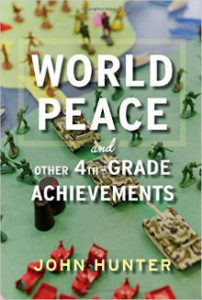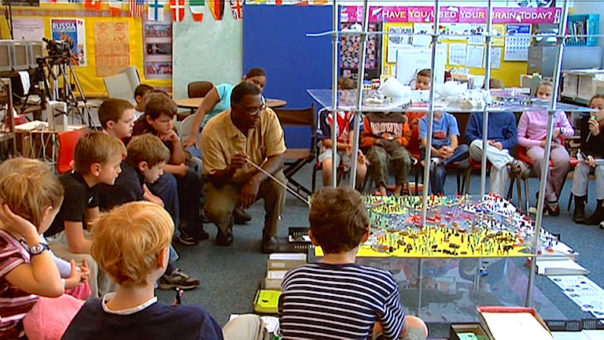Gaming World Peace with Middle Graders
World Peace and Other 4th Grade Achievements
By John Hunter
(Houghton Mifflin Harcourt Publishing, 2013 – Learn more)

It is no surprise to anyone who knows me as an educator that I am intrigued by the possibilities of games as pivot points for learning opportunities.
Not necessarily the trendy “gamification” of the classroom, where the learning environment taps into game dynamics for student motivation, but more the use of games themselves: the designing and playing of games as unique learning experiences.
So when I heard about John Hunter and his World Peace Game, I was intrigued.

Interestingly, it was Hunter’s pacifism that led to the creation of the World Peace Game, where conflict is often at the center of the action. He wanted experiential learning that might replicate the complex nature of the global stage, and built World Peace Game along those lines.
I won’t do justice to explaining all the intricacies of Hunter’s elaborate game, which can take weeks to play. Essentially, he constructed a multi-layer game board that represents land, sky, space and underwater domains. Students are part of diplomatic groups with “countries” to oversee.
As Hunter introduces “problems,” the game unfolds as countries balance security of their own lands and citizens, with the fragility of the larger world. Some countries are rich. Some are poor. There are mercenaries, hidden saboteurs, United Nations intermediaries, and more. War, famine, natural catastrophes, dwindling resources, and more all come into play during the course of the World Peace Game. A weather goddess, using coins for probability, determines the fate of many of the actions of the game.
More about the book
Hunter’s narrative in this book is built around the elements of game play that he has noticed over decades of playing and adapting the game to different situations – from his own fourth grade classroom (he is now retired from teaching) to various international youth conferences to after-school programs for gifted students. The Seven Stages of Play, as Hunter sees it, are:
- Overload and Confusion
- Failure
- Personal Understanding
- Collaboration
- “Click”
- Flow
- Application of Understanding
The chapters in World Peace move along this somewhat linear progression, as Hunter describes the game in action by focusing on the stories of students who have played the game.
There are students whose actions led to near ecological destruction of the world, only to be saved by the collaborative generosity, and forgiveness, of others. There are students whose meek natures are suddenly transformed by the responsibility of the game itself. There are students who make the connection between individual actions and collective needs. Some students see the “bigger picture” of all the interlocking problems and solutions while others struggle at every turn.
There are many stories where Hunter expresses concern that the entire game will take a wrong turn at any given moment, particularly when war is on the horizon, and the class will not “win” together by achieving peace and stability, only to be reminded again and again of the generosity of spirit and creativeness of young people. There has never been a World Peace Game where the game has not been won, according to Hunter.
Playing the game
Hunter’s book does not give a play-by-play of how to bring the game into your own classroom. And this might be because Hunter oversees a foundation that works and consults with schools and organizations and because you can purchase a documentary video about Hunter and the game.
Instead, the book provides a larger perspective, and deeper meaning, of why playing the World Peace Game is a unique learning experience unlike any other. Hunter does not shy away from the tension between this kind of classroom activity and the days of standardized testing and assessments, but he makes the case that the critical thinking and compassion skills that surface in the game are long-reaching and impactful.
Hunter wisely includes some letters from former students who wrote to him years after playing the game as evidence of his assertion that the game makes a difference.
Interestingly, Hunter focuses on two main overarching themes: empty space and Sun Tzu’s The Art of War. The emptiness is a reminder to himself that he must allow his students time and space to make decisions. He never provides the “solution” to the game’s problems, only probing questions.
In an age when the “correct answer” is expected, Hunter’s openness towards inquiry is a refreshing reminder of how discovery of knowledge is what lasts. And he uses The Art of War as a text with students, as a sort of philosophical touchstone on ways to approach conflict, and find solution.
I am left with a question of my own: Could I adapt some version of this World Peace Game for my sixth graders? Perhaps, with modifications, and within context of the very tensions that Hunter grapples with around learning and curriculum expectations. But an educator friend of mine did a modified version of the game with her students, and I am inspired by her experience.
Maybe I will roll the dice …
Kevin Hodgson is a sixth grade teacher in Southampton, Massachusetts, and is the outreach co-director with the Western Massachusetts Writing Project. Kevin blogs regularly at Kevin’s Meandering Mind and tweets more often than is healthy under his @dogtrax handle. Kevin writes for Middleweb at his Working Draft blog.


































